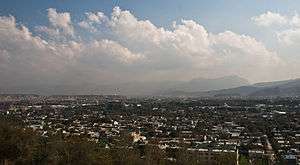Fall of Kabul
- Fall of Kabul may also refer to the Battle of Kabul (1992–1996)
| Fall of Kabul | |||||||
|---|---|---|---|---|---|---|---|
| Part of the War in Afghanistan (2001–present) and the Afghan Civil War | |||||||
 Overview of a section of Kabul City | |||||||
| |||||||
| Belligerents | |||||||
|
|
| ||||||
| Commanders and leaders | |||||||
|
| N/A | ||||||
| Strength | |||||||
| 98,000 | 58,000 | ||||||
| Casualties and losses | |||||||
|
528 killed 205 wounded |
2,314 killed 646 wounded 1,345 captured | ||||||
The Fall of Kabul took place in 2001 during the War in Afghanistan. Northern Alliance forces began their attack on the city on November 13, and made swift progress against Taliban forces that were heavily weakened by American and British air strikes. The advance moved ahead of plans, and the next day the Northern Alliance forces (supported by ODA 555)[1] entered Kabul and met no resistance inside the city. Taliban forces retreated to Kandahar in the south.[2]
Coupled with the fall of Mazar-i-Sharif five days earlier, the capture of Kabul was a significant blow to Taliban control of Afghanistan.
As a result of all the loses, surviving members of the Taliban and al-Qaeda retreated toward Kandahar, the spiritual birthplace and home of the Taliban movement and Tora Bora.[3]
References
- ↑ Neville, Leigh, Special Forces in the War on Terror (General Military), Osprey Publishing, 2015 ISBN 978-1472807908, p.43
- ↑ The United States Army in Afghanistan - Operation ENDURING FREEDOM - October 2001-March 2003
- ↑ Neville, Leigh, Special Forces in the War on Terror (General Military), Osprey Publishing, 2015 ISBN 978-1472807908, p.43